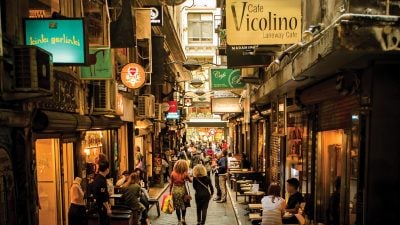Home / UK & Europe / Experience Special Musical Ven…
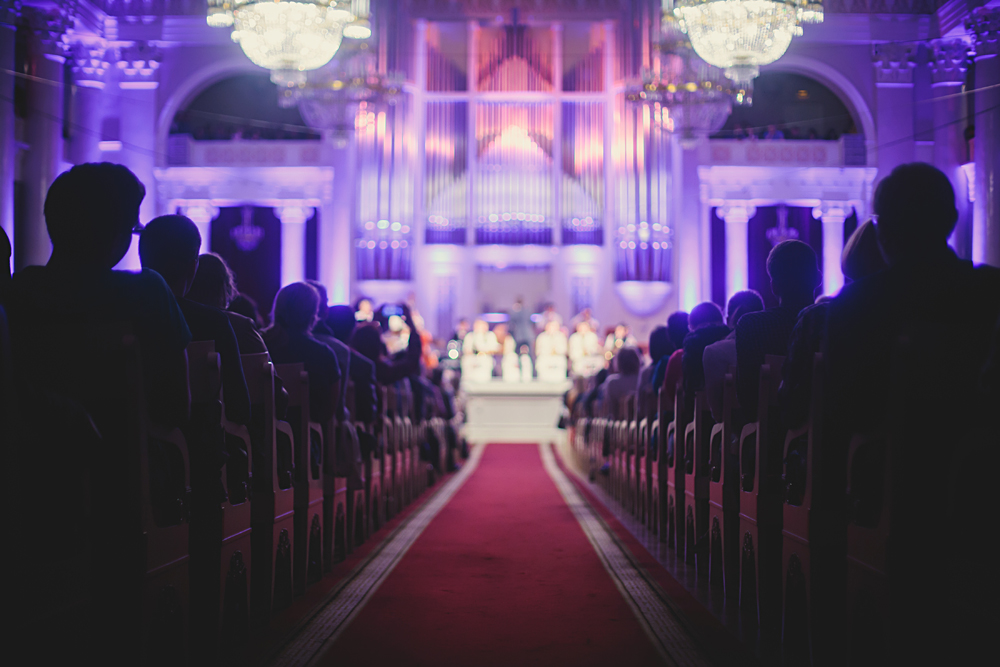
Experience Special Musical Venues on Your Europe Trip
If you are a music fan, what can be better than attending a concert or performance to add to your enjoyment while on a Europe trip. And when the venue is special, you tend to remember the event even more.
In my many years of travelling around the world, as a music lover, I have always endeavoured to fit in a concert on my visits. The venue doesn’t have to be outstanding but I have found that my musical enjoyment was enhanced by the place I heard it. You may think of the Hollywood Bowl in Los Angeles, Carnegie Hall in New York, or Massey Hall in Toronto as some of our special North American venues, and if you are conversant with them, then you will know what I mean by special. Here are some of the venues I have spent time in, during a Europe trip, and which have stayed in my mind even today.
England
The Royal Festival Hall, London
The Royal Festival Hall, located on the River Thames in London, not only offers a full schedule of classical, jazz, and popular concerts, it has, for me, the best and most outstanding city view from its balconies. You see the skyline for miles around and it is beautifully illuminated at night. Added to this are several other reasons for attending a concert here. You can have a drink and snack in the spacious, appealing lobby beforehand; you can have a pre-concert dinner in a very pleasant restaurant with the “view” (I rather belatedly had dinner there once and advised the maitre d’ that I didn’t have a lot of time. From that moment on I was given timely and amazing service); you can listen to a free pre-concert musical performance in the lobby, quite often a small jazz group.

The Royal Albert Hall, London
The Royal Albert Hall is a very special venue situated opposite Kensington Gardens. The shape of the hall from outside (round) is reflected inside, as the seats seem to totally surround the stage. When you enter the interior, you can see that the overall layout and ambience hasn’t really changed since it was opened in 1871. Musical genres performed here are eclectic and include classical, rock, and pop concerts, ballet, opera, and film screenings with live orchestra. One special time at the Royal Albert Hall is “Prom Season” (the Promenade concerts), the name of which derives from the audiences once strolling around during the concerts! The Last Night of the Proms is a special event to not miss, if you happen to be on a UK vacation, when all the seats in the middle of the auditorium are taken out and are, for the most part, occupied by raucous students and youthful enthusiasts enjoying the music standing throughout. Tours of the hall are available outside concert hours.
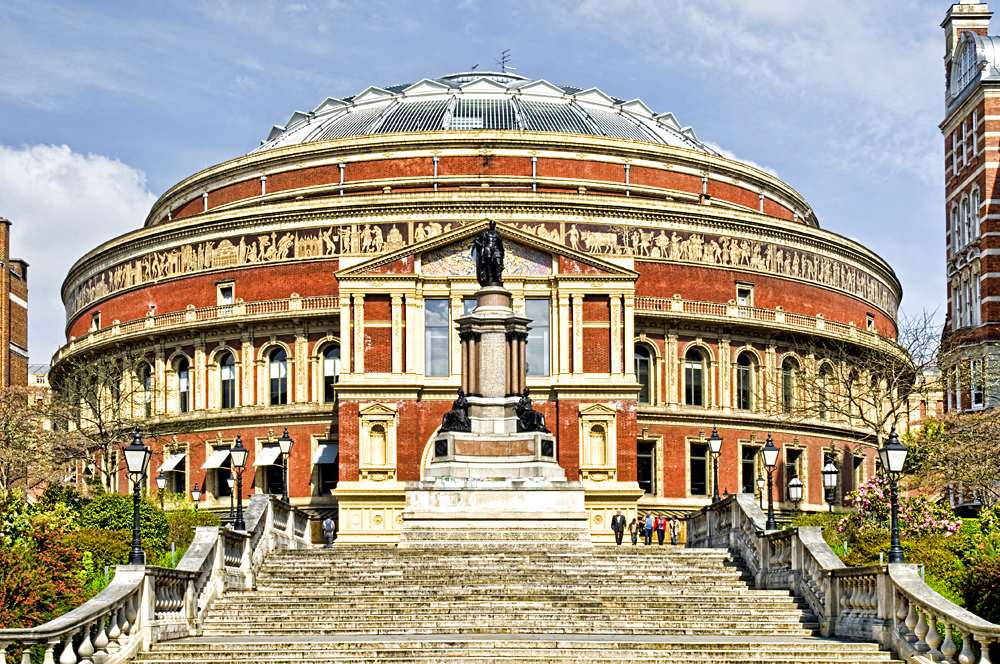
Italy
La Scala, Milan
La Scala in Milan is perhaps the best-known opera house anywhere, mainly due to its longevity and history. It was first opened in 1778 and has seen both Verdi and Toscanini conduct there. During the Second World War, La Scala was severely damaged by bombing but was rebuilt and reopened in 1946. The interior, which can seat 3,000 people, can only be described as opulent. There is, next door, the Museo Teatrale alla Scala, which can be visited on an Italy vacation and which is a museum dedicated to the history of opera, Italian in particular. The displays include costumes, set designs, autographed scores and musical instruments of historical interest as well as paintings of musicians. The Biblioteca Livia Simoni, the museum’s library, has 140,000 works related to theatre history, opera and ballet including librettos, periodicals and the correspondence of musicians, actors and dancers as well as books.

The Caracalla Baths, Rome
The Baths of Caracalla in Rome were the city’s second largest Roman public baths, built around 212AD, but fell into disuse and ruin. The central part of this bath complex was the summer home of the Rome Opera company, but since 2001 it now uses a temporary movable stage outside of the main structure of the baths to reduce the stress on the antique ruins. This was the venue for the iconic Three Tenors concert in 1990 (Pavarotti, Domingo, and Carreras). I was fortunate enough to enjoy an opera inside the actual baths.

The Arena, Verona
Built in the 1st century AD, Verona’s Roman amphitheatre survived an earthquake to become the city’s legendary open-air opera house, with seating for 15,000 people, which allows it to host the summer opera festival. It is the 8th largest amphitheatre in the Roman Empire and predates even the Colosseum in Rome. The amphitheatre is completely in the open air. One time, I attended a performance of Verdi’s Aida and was amazed by two things. One was that everyone was given a lit candle before the performance which we all waved around to great atmospheric effect, and the other was to see a live camel cross the stage in one scene.
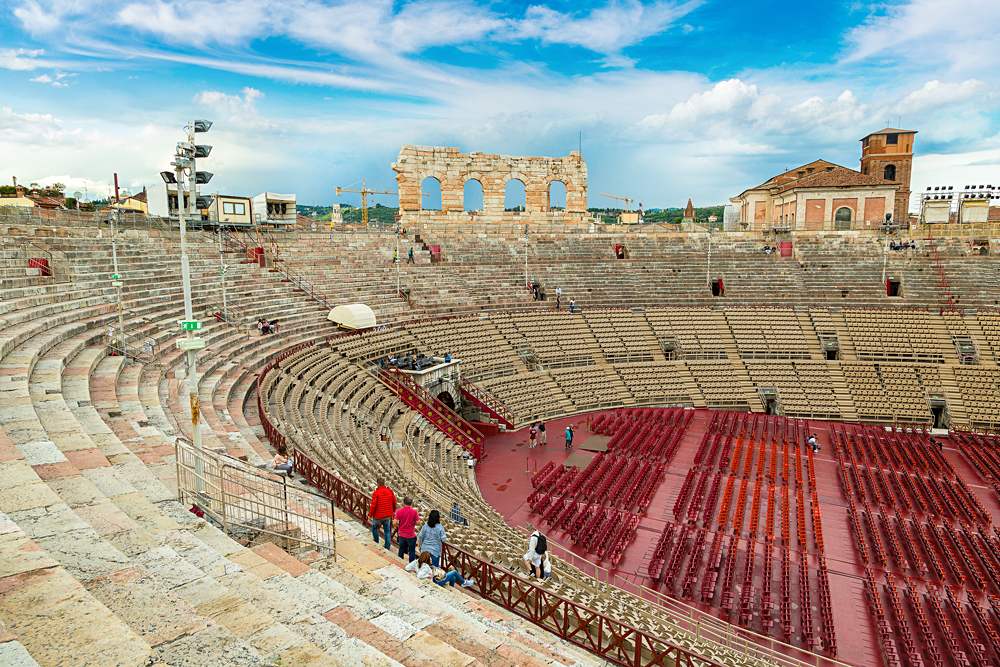
Germany
The Philharmonie Hall, Berlin
The Berliner Philharmonie is home to the world-famous Berlin Philharmonic Orchestra. The building itself is unique, both inside and outside. It is acclaimed for both its acoustics and its architecture. It is located in Berlin on Herbert Von Karajan Street, named after the legendary and longest-serving conductor of the orchestra. It has two auditoriums, the large hall which seats 2440 people and the chamber music hall which can hold 1180 people. The seating is rather unusual as the stage is in the centre of the hall and the seats surround it on all sides. This gives the audience excellent viewing.

State Opera House, Berlin
The Berlin State Opera (or as it is known locally, the Staatsoper), is wonderfully located on the elegant avenue, Unter Den Linden. The German Opera Company uses it as their permanent home. It was originally opened in 1742. At one time, the Nazis took control of the Staatsoper after they assumed power in 1933. Several composers’ works were banned and the repertoire and staging were planned to support the Nazi agenda. This is a gorgeous opera house which, outside is completely white and inside very opulent. I have two vivid memories of attending a performance here on a one-time German vacation. One was arriving at the opera house and realizing I had left the tickets in my hotel room. I had to take a taxi and collect them, returning minutes before the performance started. The other was the performance of Richard Strauss’s opera, Ariadne auf Naxos, an opera which would normally be performed in a traditional way, but this time was performed with the lead female singer dressed as a punk rocker with pink hair, the lead male singer dressed as Elvis Presley, and a scene where some of the chorus roller bladed up and down a ramp.

Russia
Bolshoi Theatre, Moscow
The Bolshoi Theatre opened in Moscow in 1825 and has to be one of the world’s most famous opera and ballet performance halls. Bolshoi translates as “big.” Funnily enough, in 1918 Vladimir Lenin insisted on demolishing the building as he said that opera was a bourgeois art, cost too much, and that the performers were arrogant. However, Joseph Stalin changed Lenin’s mind, thank goodness. The Bolshoi Ballet and Bolshoi Opera are among the oldest and most renowned ballet and opera companies anywhere. Any performances I have experienced have been of a very high standard, and the audiences have always been very enthusiastic. It is by far the world’s biggest ballet company, with more than 200 dancers. I am not certain if this is still the case, but there were times when I went there that what was going to be performed was not announced until a few days before, so if attending a performance on a Russia vacation, check what is on. The Bolshoi normally introduces two to four new ballet or opera productions each season. The sets and costumes for most productions are made in the Bolshoi’s own workshops.

Mariinsky Theatre, St. Petersburg
The Mariinsky Theatre is St. Petersburg’s answer to the Bolshoi. The Mariinsky Ballet is one of the oldest ballet companies, and the Mariinsky Theatre is one of the oldest theatres in the world. This venue is named after the wife of the Tsar Alexander II, Empress Maria Alexandrovna. Inside, there is a royal box enriched with imperial eagles, curtains, and sparkling chandeliers. The tsars regularly watched performances from this box. Famous names such as Pavlova, Nijinsky, Nureyev, and Baryshnikov have all performed here. The building originally dates back to 1783, although it has gone through several modifications since, as well as name changes.

France
Church of the Madeleine, Paris
The Eglise de la Madeleine (in French) is situated near the Place de la Concorde. Its construction was completed in 1842 in the form of a Greek temple with Corinthian columns surrounding the building. It seems Napoleon wanted it to be a pantheon in honour of his armies. Inside, there are interesting sculptures and paintings. There is also a magnificent church organ. So, what better venue than this somewhat cavernous church in which to attend a concert on travel to Paris. The church offers Sunday concerts of classical music and there are also other concerts on different days throughout the year.

The Netherlands
The Royal Concertgebouw, Amsterdam
Bernard Haitink, the conductor, once praised The Royal Concertgebouw as the best instrument of the orchestra. Because of its highly regarded acoustics, The Concertgebouw is considered one of the finest concert halls in the world. This majestic and ornate concert hall was first opened in 1888, with an inaugural concert in which an orchestra of 120 musicians and a chorus of 500 singers participated. Unbelievably, around 900 concerts and other events take place each year here, with audiences of more than 800,000 making it one of the most-visited concert halls. Apart from the classical music concerts, jazz and pop shows are held in the Concertgebouw, as well as special events. On an Amsterdam vacation, you can go behind the scenes on a guided tour.
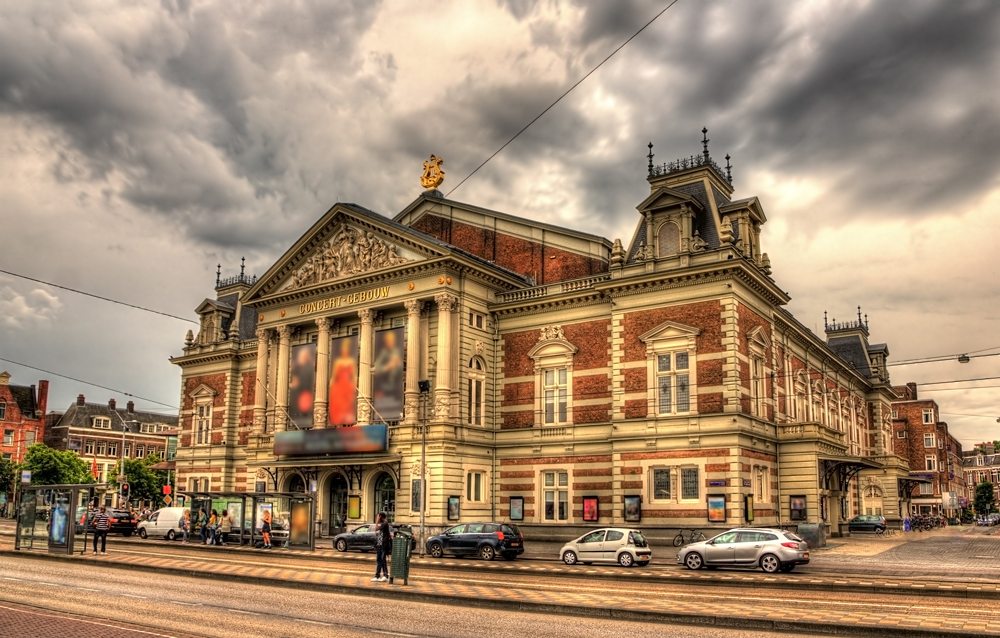
Bimhuis, Amsterdam
Built in 2005, this modern structure is located on the southern bank of the IJ River, which separates Amsterdam’s centre from the northern suburbs. It is a concert hall for jazz and improvised music, with an average of 150 performances a year. Many jazz greats have performed here, together with the cream of local Dutch musicians. The building is a state of the art music venue with cutting-edge acoustics. The concert hall seats around 200 people. Tuesday nights are jam session nights and attract quality musicians. There is also a good restaurant and a bar.

Spain
The Palau de la Musica Catalana, Barcelona
Palau de la Musica Catalana opened in Barcelona in 1908. It is one of the most architecturally interesting concert halls I have ever experienced on trips to Spain. It has been declared a UNESCO World Heritage Site, it is so unique. To quote, “The design of the Palau is typical of Catalan modernism in that curves predominate over straight lines, dynamic shapes are preferred over static forms and rich decoration that emphasizes floral and other organic motifs is used extensively.” Performances range from symphonic and chamber music to jazz and Canco (Catalan song). The concert hall seats about 2200 people and is the only auditorium you’ll find on a Europe trip that is illuminated entirely by natural light during daylight hours. The walls on two sides consist mainly of stained glass and overhead is an enormous skylight of stained glass.
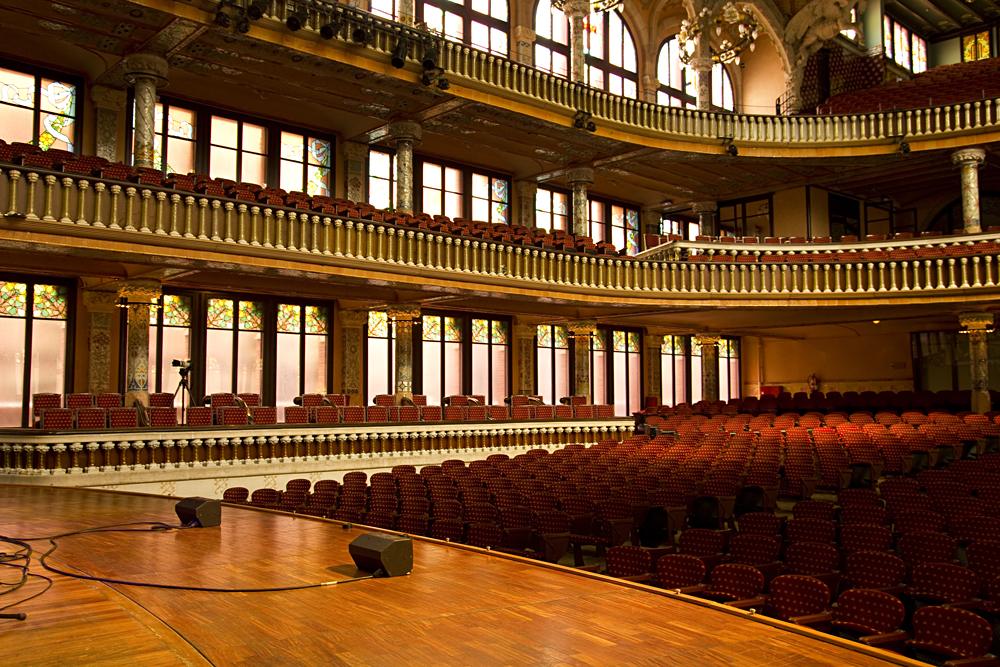
Portugal
Casa da Musica, Porto
Casa da Musica in Porto is a stark contrast to the Palau de la Musica in Barcelona. It is very modern, designed by the Dutch architect, Rem Koolhaas, and has been described as minimalist, daringly imaginative, and to quote, “A wonky cuboid which conceals a shoebox-style concert hall lauded for some of the world’s best acoustics.” It opened in 2005, with a performance by Lou Reed, followed the next day by a performance given by the Porto National Orchestra. It is the only concert hall in the world with two walls made entirely of glass. The auditorium is lined with timber and embellished with gold leaf to create the effect of a giant wood-grain pattern. A baroque organ has been fixed to a wall.
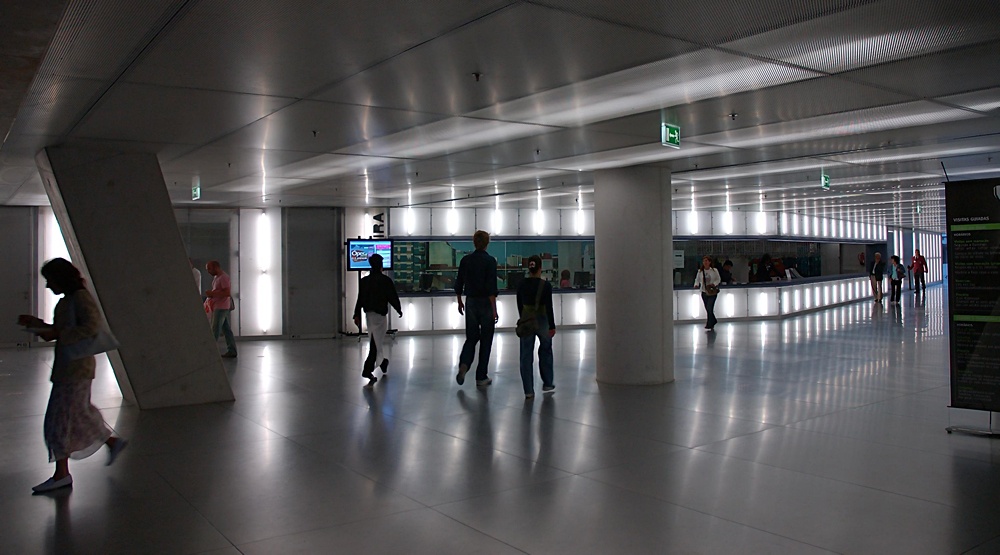
Iceland
Harpa, Reykjavik
When I first set eyes on Harpa, I was drawn to investigating the building and the auditorium. It really stands out and is one of Reykjavik’s most prominent landmarks. Its award-winning architecture has attracted 7 million guests since it opened in 2011. In the opening concert, the Iceland Symphony Orchestra performed under Vladimir Ashkenazy. Its full title is Harpa Reykjavik Concert Hall and Conference Centre and was chosen the best performance venue in 2011 by Travel & Leisure magazine and won the Mies van der Rohe Award for contemporary architecture in 2013. Various music festivals that can be experienced on an Iceland vacation are held regularly in the building, such as the Reykjavik Midsummer Music, the Reykjavik Arts Festival, and the Reykjavik Jazz Festival. It is the home of the Iceland Symphony Orchestra, the Icelandic Opera, and the Reykjavik Big Band.

Finland
Savonlinna Opera Festival
My last selection is one of the most impressive settings for lovers of opera who are on Finland vacations. The Savonlinna Opera Festival takes place at the medieval Olavinlinna (St. Olaf’s Castle), built in 1475. The castle is situated on the side of a lake. The first opera festival was held in 1912, but for 55 years was abandoned. Now, each year, an estimated 60,000 attend the festival. The unique 2264-seat castle auditorium has excellent acoustics and is protected by an awning from wind and rain. The festival takes place during the months of July and August.

You may have also personally attended concerts at other remarkable venues. For my part, I will continue to pursue them, both on a Europe trip and other globetrotting getaways.
Get more travel inspiration by email.
Subscribe
0 Comments

Get the latest travel trends & hear about the best deals on vacations around the world.
If you’re a Globetrotter, these are the newsletters for you!
